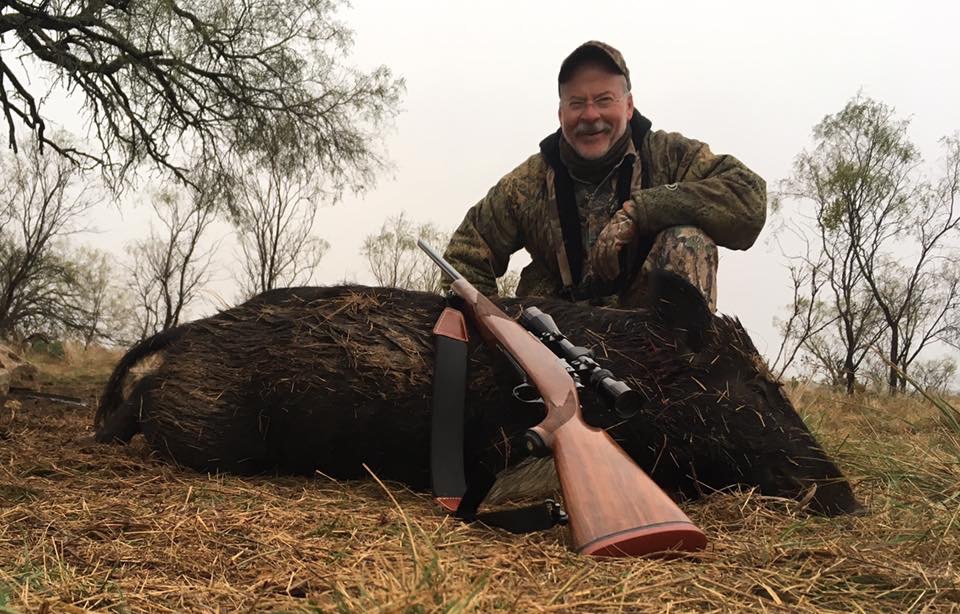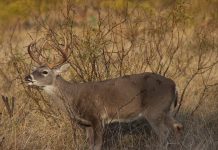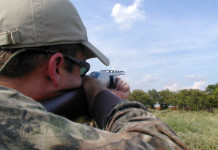Feral hogs in Texas can’t be controlled.
It’s a fact rooted in destruction of native habitats as the swine descended from those introduced by Spanish explorers explode exponentially across our Lone Star State landscape.
That’s not to say that we Texans aren’t doing our best to thin the state’s herd estimated at between 3 million and 4 million critters, and rising fast.
We can shoot them from helicopters (“pork chopping”), we can trap them all year long, and we can even hunt them at night using high-tech thermal imaging gear suited for military use.
And yet, despite these most liberal of means and methods, we’re losing the war on prolific pigs.
Enter Texas Agriculture Commissioner Sid Miller and his decision to build a better mouse trap — or at least allow use of a toxicant better suited for rodents — to quell the “hog apocalypse.”
Miller’s announcement in February of the approval by emergency rule of Kaput Feral Hog Lure — a product containing the blood thinner warfarin — created quite a stir of controversy, if not some hysteria. The move brought more questions than answers about the use of a product containing an ingredient used in high doses to kill mice and rats, and in lower doses in humans to treat blood clots and to prevent stroke in those with heart disease.
There’s no doubt that feral hogs are detrimental to farmlands and native habitats. Miller noted in a news release that wild pigs cause an estimated $52 million of damage to agricultural enterprises each year, according to the Texas A&M Agrilife Extension Service. It should be noted that that figure is actually from 2008 so it’s undoubtedly higher than that with the proliferation of pigs, now found in roughly 90 percent of Texas counties.
The news release also noted that the Environmental Protection Agency has determined the product to be available for general use because of its low toxicity. It went on to add that the Texas Department of Agriculture “has imposed stricter regulations on the product by labeling it for limited use only. State-limited-use pesticides may only be bought and used by a licensed applicator or someone under the direct supervision of a licensed applicator.”
As the ballyhooed announcement garnered lots of attention from state and national media, it also generated a large pushback from hunting and conservation groups.
In response to Miller’s move, Jan Soifer, Judge of the 345th District Court of Travis County, on Wednesday issued a temporary restraining order prohibiting Miller and the Texas Department of Agriculture from implementing the use of Kaput.
The plaintiff in the case was Wild Boar Meats, a feral-hog processing business in Hubbard. The Texas Hog Hunters Association, which has received more than 15,000 signatures through an online petition objecting to the implementation of Kaput, intervened on the side of Wild Boar Meats.
“Spreading rat poison across Texas lands would hurt Texas hunters, Texas hunting-supply businesses, Texas feral-hog meat processing businesses, Texas ranchers, and the Texas environment,” according to a statement from the Association. “We hope that Commissioner Miller will now follow the law and allow public comment and careful consideration before proposing use of any poison on feral hogs. The emergency rule would have damaged feral-hog control in Texas rather than helping it.”
In announcing the emergency rule approving the warfarin-based Kaput, Miller noted that hunters or landowners would be able to tell if a hog was killed by the poison because its fat would turn blue due to a dye imparted in the toxicant. He also touted the use of warfarin to curb the hog population in Australia, though the poison is being phased out there because it’s considered “inhumane.”
Kaput, manufactured by Colorado-based Scimetrics, does carry a warning label with several statements that certainly should raise some eyebrows and raise plenty of questions in an official public comment period.
One warning includes the following: “This product may be toxic to fish, birds and other wildlife. Dogs and other predatory and scavenging mammals and birds might be poisoned if they feed upon animals that have eaten the bait.”
Another warning advises that hog carcasses that result from warfarin poisoning should be buried “at least 18 inches below the ground surface.”
The Texas Department of Agriculture, which tested Kaput on feral hogs in the Rolling Plains area between Turkey and Crowell, found that the poison must be delivered in a specific way, namely through a closed feeder that only hogs have the ability to open. That in and of itself raises a large question surrounding just how heavy a feeder door or latch must be that has yet to be answered by any researcher.
Texas Parks & Wildlife, in a short statement after Miller’s move, noted that it effectively was not consulted and had yet to issue a scientific position on the poisoning of hogs with warfarin-based products:
“Texas Parks and Wildlife Department has received numerous inquiries regarding the recent announcement from the Texas Department of Agriculture that the Warfarin-based toxicant, Kaput, has been approved for feral hog control in Texas. TPWD has recognized for many years that feral hogs pose substantial risks due to the damage they cause to wildlife, lands, habitat and crops. While TPWD has supported and encouraged responsible feral hog control management practices, it has not yet evaluated the risks and impacts this toxicant may have on non-target species when used as a means to control feral hog populations. TPWD is in the process of requesting the research information utilized by the EPA in recently approving the use of Kaput as a feral hog toxicant. Once an assessment of the research on Kaput is completed, TPWD hopes to express its position on the risks the use of this toxicant may have on Texas wildlife.”
One toxicant that TPWD has tested with positive pig reduction results is sodium nitrite. That research on hogs, deer, raccoons and other critters has been conducted at the Kerr Wildlife Management Area for a number of years and is ongoing. That research has shown that the toxicant won’t have detrimental impacts on the food chain or ecosystem since it reduces a hog’s ability to absorb oxygen into the bloodstream and is rendered harmless when exposed to air or water.
A Texas A&M University report from 2012 compiled by scientists and biologists highlighted suitable habitat and attributes related to the growing population of feral hogs for historical estimation purposes. The bottom line was this, according to the study: if left unchecked, the state’s feral hog tally — which was averaged at roughly 2.6 million animals at the time — will more than triple in five years.
The most glaring figure from the report is the reduction rate necessary to keep the population in check. Roughly 66 percent of the animals must be taken off the range annually to keep their ranks from growing.
The report also relied on nearly two dozen other scientific studies to show just how quickly and how prolific feral hogs can reproduce. The invasive species, which has the highest reproductive rate of any hoofed animal, hits reproductive maturity at roughly eight months on average, according to those studies, and produces an average of 1½ litters each year. Those litters may only have an average of four to six piglets, according to TPWD biologists, but it’s not uncommon for them to have twice that many.
The The Texas Department of Agriculture is currently accepting feedback on the use of poison for feral hogs.






















This article was very informative, thank you for SHARING your knowledge